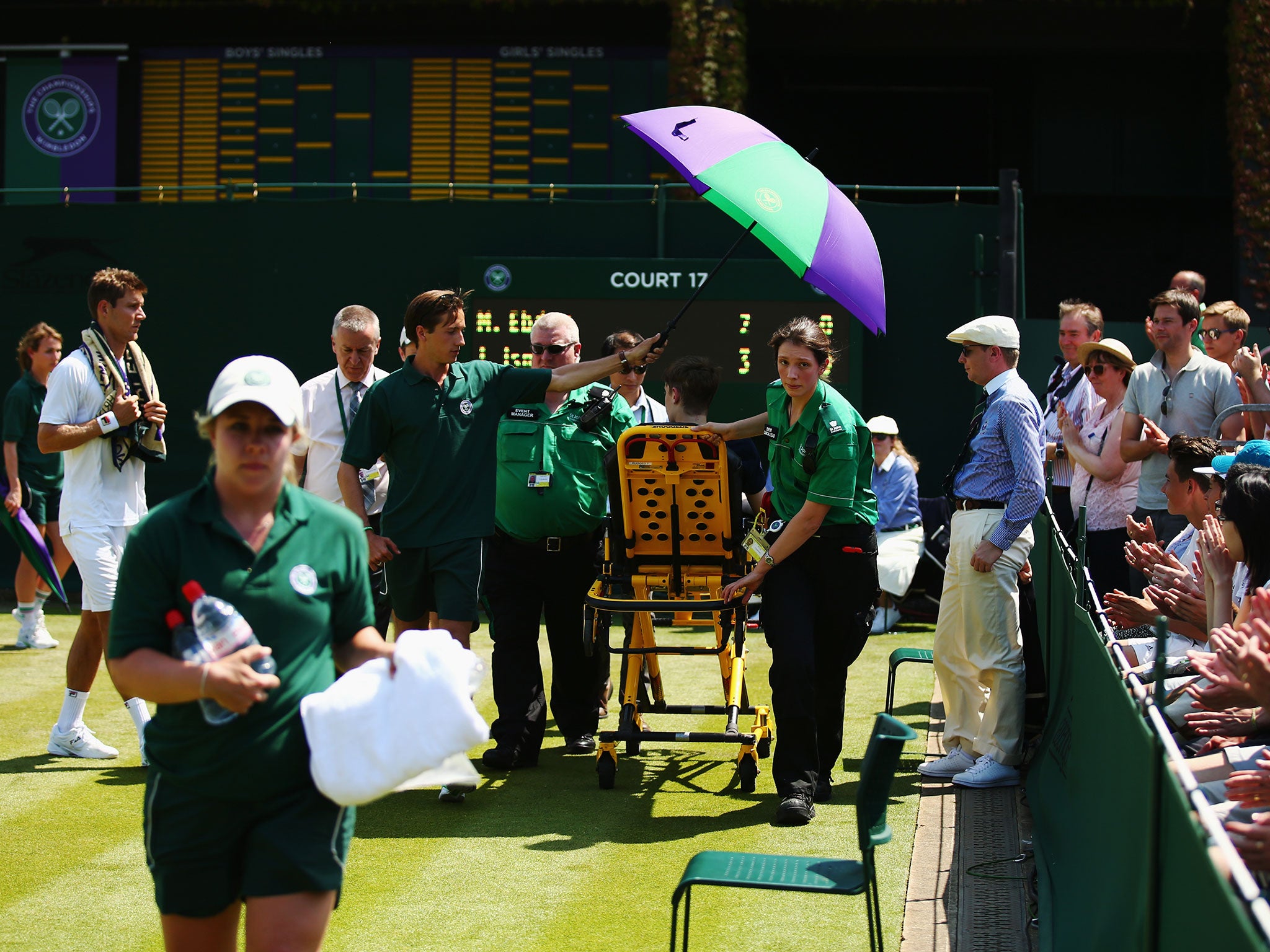Wimbledon 2015: Championships feel the heat of record-breaking day – unless you're in royal box
Ball boy collapses and players suffer as temperatures rocket, while Jeremy Corbyn seeks a law against working in high temperatures

Your support helps us to tell the story
From reproductive rights to climate change to Big Tech, The Independent is on the ground when the story is developing. Whether it's investigating the financials of Elon Musk's pro-Trump PAC or producing our latest documentary, 'The A Word', which shines a light on the American women fighting for reproductive rights, we know how important it is to parse out the facts from the messaging.
At such a critical moment in US history, we need reporters on the ground. Your donation allows us to keep sending journalists to speak to both sides of the story.
The Independent is trusted by Americans across the entire political spectrum. And unlike many other quality news outlets, we choose not to lock Americans out of our reporting and analysis with paywalls. We believe quality journalism should be available to everyone, paid for by those who can afford it.
Your support makes all the difference.As Britain sweltered in record-breaking heat, players, staff and most spectators at Wimbledon found themselves with no place to hide from the blazing sun.
After a level-three heatwave was declared by the Met Office and temperatures hit 36.7C (98F) at Heathrow to break the record for July, Public Health England advised everyone to keep out of the sun between 11am and 3pm.
The heat – not far off the all-time record of 38.5C (101F) near Faversham, Kent, on 10 August 2003 – caused trains to be cancelled as tracks buckled, melted asphalt on roads and led to a spike in ambulance callouts, particularly in South-east England.
While rain may stop play at Wimbledon, such balmy weather apparently does not. Players complained of feeling dizzy, a ball boy collapsed under the midday sun and dozens of spectators were treated for the effects of the heat.
However, not everyone was troubled by the glare of direct sunlight.
The moveable roof at Centre Court was carefully positioned to form a protective canopy over the royal box, which contained the Duke of Kent and the Duchess of Gloucester among other specially invited guests.
“The roof does move to provide shade to the Royal Box end of Centre Court,” a Wimbledon spokesman confirmed. The arrangement has previously led to claims of unfair treatment, but the spokesman said the moving roof was merely replicating the shade provided by the court’s old canopy.

Exposure to such heat could be outlawed under an Early Day Motion tabled in Parliament by Jeremy Corbyn, a Labour leadership contender. He hopes to gain government support for a trade union campaign for a maximum working temperature of 30C – or 27C where work involves strenuous activity – to be introduced into law. “Good employers will have been taking steps to help out their workers in the heatwave,” he said. “But putting a maximum temperature into law will give everyone a legal right to basic protections from working in unbearable conditions.”
One person who might have appreciated a cool-down was the Australian tennis player Bernard Tomic, who called for his trainer after complaining of feeling light-headed during the second set of his match against the Frenchman Pierre-Hugues Herbert.

“I was fatigued and starting to get dizzy out there with the heat hitting me,” he said, adding that it was a topic of discussion in the men’s locker room. “I just haven’t been sleeping well here, it’s been too hot.”
St John Ambulance said that its medics had treated 123 people at Wimbledon and taken two to hospital, with a majority suffering from heat-related conditions. The ball boy, who collapsed shortly before 2pm, recovered well but was sent to hospital for “a precautionary check-up”, a Wimbledon spokesman said.
The heat caused a surge in calls for emergency help across South-east England in particular. London Ambulance Service said it had seen callouts to people who had fainted increase by more than a third compared with the same day last week.
And South East Coast Ambulance Service said calls between 10pm on Tuesday and noon Wednesday had doubled compared with the same period last week. A spokeswoman said the calls were mainly from the elderly or people with long-term conditions who are suffering as a result of the heat, rather than for sunburn or heat exhaustion.
However South West Ambulance Service said clouds and a cooling breeze had helped people in that area cope with the heat and it had seen little change to its normal level of callouts. Yorkshire Ambulance Service reported “only a slight increase in any calls related to heat exposure”.
Centra Pulse, which provides a personal alarm service, said it received more than 500 calls an hour at times compared with the usual average of 300.
Among those who needed emergency help was Becky Bridgeman, 30, when she suffered an epileptic seizure in her back garden in Dover triggered by the heat. One of the company’s operators called an ambulance after her fall detector sensor was activated and paramedics broke into the garden to administer a breathing tube to get her oxygen levels back up to normal.
An NHS England spokeswoman said: “We would urge people to take care during this heatwave period, ensuring they are sensible when it comes to the amount of time they spend in the sun, use adequate sun screens and ensure they don’t become dehydrated, while also taking steps to keep their homes and work places as cool as possible. We would also ask people to look in on elderly, children or vulnerable family, friends and neighbours to ensure they are coping with the conditions.”
The heat also hit transport networks. A spokeswoman for Network Rail said metal tracks could get 20C hotter than the air temperature and there was a risk they could buckle. Speed restrictions were put in place on several lines and there were also a number of cancellations.
Water was also handed out to passengers at Greater Anglia stations, including Ipswich and Norwich, as health experts urged people to keep hydrated.
The AA said it had received “anecdotal reports from patrols that show that in places the road surface is softening, but there are no widespread problems at the moment”. “There was a man who put the stand down on his motorbike and it sank into the tarmac. The roads are soft in places. We have been very, very busy today,” a spokesman for the motorists’ body added.
Join our commenting forum
Join thought-provoking conversations, follow other Independent readers and see their replies
Comments